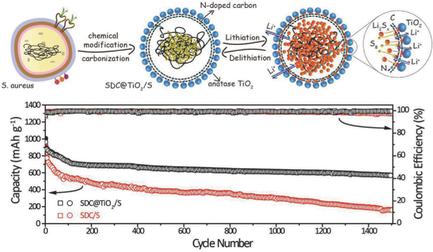当前位置:
X-MOL 学术
›
Adv. Energy Mater.
›
论文详情
Our official English website, www.x-mol.net, welcomes your
feedback! (Note: you will need to create a separate account there.)
Biomimetic Bipolar Microcapsules Derived from Staphylococcus aureus for Enhanced Properties of Lithium–Sulfur Battery Cathodes
Advanced Energy Materials ( IF 24.4 ) Pub Date : 2018-01-17 , DOI: 10.1002/aenm.201702373 Wenlu Wu 1 , Jun Pu 1 , Jian Wang 1 , Zihan Shen 1 , Haiyan Tang 1 , Zhentao Deng 1 , Xinyong Tao 2 , Feng Pan 3 , Huigang Zhang 1
Advanced Energy Materials ( IF 24.4 ) Pub Date : 2018-01-17 , DOI: 10.1002/aenm.201702373 Wenlu Wu 1 , Jun Pu 1 , Jian Wang 1 , Zihan Shen 1 , Haiyan Tang 1 , Zhentao Deng 1 , Xinyong Tao 2 , Feng Pan 3 , Huigang Zhang 1
Affiliation

|
Lithium–sulfur (Li–S) batteries suffer from some serious issues, such as volume expansion, polysulfide migration, and so on, which lead to inferior rate properties, low Coulombic efficiency, and poor cycling stability. To a great extent, the significantly changing polarities, conductivities, and solubilities of sulfur species complicate these issues and make them hard to deal with. In this study, a biomimetic bipolar microcapsule is developed via bacteria fermentation and chemical modification. The biomimetic hierarchical microcapsule has a nonpolar core to load active materials and a polar shell to “selectively” control mass transport in and out. Each capsule acts as a microreactor, which adsorbs sulfur with the porous carbon core, retards polysulfide migration with the polar TiO2 shell, and only facilitates lithium ion diffusion through the shell. The advantages of bipolar microcapsules are able to concurrently address S hosting, electron conducting, and polysulfide migration issues in particle scales instead of electrode scales. Because the resulting sulfur cathodes effectively interact with all sulfur species and confine them inside microcapsules, those intractable issues that lead to poor cycling properties are significantly managed. Thus, a high specific capacity and excellent cycling stability are achieved by using this novel structure design.
中文翻译:

源自金黄色葡萄球菌的仿生双极微胶囊可增强锂硫电池正极的性能
锂硫(Li–S)电池存在一些严重问题,例如体积膨胀,多硫化物迁移等,这些问题导致速率特性下降,库仑效率低和循环稳定性差。在很大程度上,硫物质的极性,电导率和溶解度的显着变化使这些问题变得复杂,并使它们难以处理。在这项研究中,通过细菌发酵和化学修饰开发了仿生双极微胶囊。仿生分层微胶囊具有一个非极性核心以装载活性物质,并具有一个极性壳以“选择性地”控制物质的进出。每个胶囊都充当微反应器,该微反应器通过多孔碳核吸附硫,阻止多硫化物与极性TiO 2的迁移壳,并且仅促进锂离子通过壳扩散。双极微胶囊的优点是能够同时解决颗粒级而非电极级的S托管,电子传导和多硫化物迁移问题。由于生成的硫阴极可以有效地与所有硫物质相互作用并将其限制在微囊内,因此可以有效解决导致循环性能差的棘手问题。因此,通过使用这种新颖的结构设计,可以获得高的比容量和优异的循环稳定性。
更新日期:2018-01-17
中文翻译:

源自金黄色葡萄球菌的仿生双极微胶囊可增强锂硫电池正极的性能
锂硫(Li–S)电池存在一些严重问题,例如体积膨胀,多硫化物迁移等,这些问题导致速率特性下降,库仑效率低和循环稳定性差。在很大程度上,硫物质的极性,电导率和溶解度的显着变化使这些问题变得复杂,并使它们难以处理。在这项研究中,通过细菌发酵和化学修饰开发了仿生双极微胶囊。仿生分层微胶囊具有一个非极性核心以装载活性物质,并具有一个极性壳以“选择性地”控制物质的进出。每个胶囊都充当微反应器,该微反应器通过多孔碳核吸附硫,阻止多硫化物与极性TiO 2的迁移壳,并且仅促进锂离子通过壳扩散。双极微胶囊的优点是能够同时解决颗粒级而非电极级的S托管,电子传导和多硫化物迁移问题。由于生成的硫阴极可以有效地与所有硫物质相互作用并将其限制在微囊内,因此可以有效解决导致循环性能差的棘手问题。因此,通过使用这种新颖的结构设计,可以获得高的比容量和优异的循环稳定性。











































 京公网安备 11010802027423号
京公网安备 11010802027423号